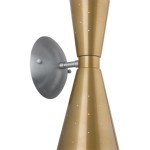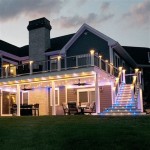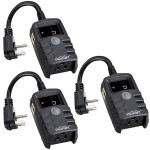Best Outdoor Lights with Sensors: Illuminating Your Property with Efficiency and Security
Outdoor lighting plays a crucial role in enhancing the security, safety, and aesthetic appeal of residential and commercial properties. Among the diverse options available, outdoor lights equipped with sensors offer a blend of convenience and energy efficiency. These lights automatically activate when motion is detected or when ambient light levels fall below a certain threshold, providing illumination only when and where it's needed. This article explores the various aspects of outdoor lights with sensors, including their types, benefits, selection criteria, and installation considerations.
Types of Sensors Used in Outdoor Lighting
The functionality of outdoor lights with sensors hinges on the type of sensor integrated into the fixture. Different sensor technologies offer varying levels of sensitivity, range, and responsiveness. Understanding these differences is essential when choosing the right light for specific needs.
Motion Sensors: These sensors detect movement within a defined area. They are commonly used for security purposes, as they can trigger lights to illuminate when someone approaches a property. Motion sensors typically rely on one of two technologies:
Passive Infrared (PIR) Sensors: PIR sensors detect changes in infrared radiation emitted by warm objects, such as people, animals, and vehicles. They are relatively inexpensive and effective at detecting motion within their field of view. However, PIR sensors can be prone to false triggers caused by heat sources, such as sunlight or car exhaust.
Microwave Sensors: Microwave sensors emit microwave radiation and detect changes in the reflected signal caused by moving objects. They are less susceptible to false triggers than PIR sensors and can detect motion through walls and other obstacles. However, microwave sensors are generally more expensive than PIR sensors.
Photocells (Dusk-to-Dawn Sensors): Photocells, also known as dusk-to-dawn sensors, detect ambient light levels. They automatically turn lights on when it gets dark and off when it gets light. These sensors are ideal for providing continuous illumination throughout the night, enhancing safety and security.
Combination Sensors: Some outdoor lights feature a combination of motion and photocell sensors. These lights can be programmed to turn on automatically at dusk and remain on at a low level of brightness until motion is detected, at which point they switch to full brightness. This approach offers both energy efficiency and enhanced security.
Benefits of Using Outdoor Lights with Sensors
The integration of sensor technology into outdoor lighting provides numerous advantages, making them a preferred choice for many property owners.
Enhanced Security: Motion-activated lights can deter potential intruders by illuminating the area when movement is detected. This sudden burst of light can surprise and discourage trespassers, making the property less appealing as a target.
Increased Safety: Outdoor lights with sensors can improve safety by illuminating pathways, steps, and other potentially hazardous areas. This is particularly beneficial at night, when visibility is reduced, helping to prevent accidents and injuries.
Energy Efficiency: By only turning on when needed, sensor-equipped lights consume significantly less energy than lights that remain on continuously. This translates to lower electricity bills and a reduced carbon footprint.
Convenience: The automatic operation of sensor lights eliminates the need to manually switch lights on and off. This is particularly convenient for homeowners who are away from home or who have mobility limitations.
Extended Bulb Life: Since the lights aren't constantly running, the lifespan of the light bulbs is extended, reducing the frequency of bulb replacements and saving money on maintenance.
Key Considerations When Choosing Outdoor Lights with Sensors
Selecting the right outdoor lights with sensors requires careful consideration of several factors to ensure they meet specific needs and preferences.
Sensor Sensitivity and Range: The sensitivity of the sensor determines how easily it detects motion or changes in light levels. The range specifies the area covered by the sensor. Consider the size of the area to be illuminated and the desired level of sensitivity when choosing a light. For larger areas, a light with a wider range and adjustable sensitivity is recommended. For smaller entryways, a narrower range may suffice.
Light Output (Lumens): Lumens measure the total amount of visible light emitted by a light source. The required light output depends on the size of the area to be illuminated and the desired level of brightness. For general outdoor lighting, a light with 400-800 lumens may be sufficient. For security lighting, a brighter light with 800-1600 lumens is recommended.
Light Source Type: Outdoor lights with sensors are available with various light source options, including LED, incandescent, and halogen bulbs. LEDs are the most energy-efficient option, offering long lifespan and low energy consumption. Incandescent and halogen bulbs are less energy-efficient and have shorter lifespans.
Weather Resistance: Outdoor lights are exposed to the elements, so it's crucial to choose lights that are designed to withstand rain, snow, heat, and cold. Look for lights with a high IP (Ingress Protection) rating, which indicates the level of protection against dust and water. An IP rating of IP65 or higher is recommended for outdoor use.
Design and Style: Outdoor lights should complement the architecture of the property and the overall aesthetic. Choose a style that matches the existing outdoor decor and enhances the curb appeal of the property.
Adjustability: Some outdoor lights with sensors offer adjustable settings for sensitivity, range, and on-time. This allows for customization to meet specific needs and preferences. The ability to adjust these settings helps to minimize false triggers and optimize energy consumption.
Power Source: Outdoor lights with sensors are available in wired and solar-powered options. Wired lights require a connection to the electrical grid, while solar-powered lights rely on solar energy to charge their batteries. Solar-powered lights are a good option for areas where wiring is not feasible or desirable, but their performance may be affected by weather conditions.
Installation and Maintenance of Outdoor Lights with Sensors
Proper installation and maintenance are essential for ensuring the optimal performance and longevity of outdoor lights with sensors.
Installation: Wired lights should be installed by a qualified electrician to ensure safety and compliance with local electrical codes. Solar-powered lights are generally easier to install, but it's important to choose a location that receives ample sunlight. Follow the manufacturer's instructions carefully during installation.
Sensor Placement: The placement of the sensor is crucial for accurate detection. Avoid placing sensors near heat sources, such as air conditioners or exhaust vents, as this can cause false triggers. Position the sensor so that it has a clear view of the area to be monitored.
Regular Cleaning: Dust, dirt, and debris can accumulate on the sensor and lens, reducing their effectiveness. Clean the sensor and lens regularly with a soft, dry cloth.
Bulb Replacement: When replacing bulbs, use the correct type and wattage as specified by the manufacturer. Ensure that the light is turned off before replacing the bulb.
Battery Maintenance (for Solar Lights): Solar-powered lights require regular battery maintenance. Replace the batteries as needed to ensure optimal performance. Clean the solar panel regularly to remove dust and debris.
Troubleshooting: If the light is not working properly, check the power source, bulb, and sensor settings. Consult the manufacturer's instructions for troubleshooting tips. If the problem persists, contact a qualified electrician.

10 Best Ing Outdoor Motion Sensor Lights For 2024 The Jerum Post

Best Outdoor Motion Sensor Lights 2024 Security
The Best Outdoor Motion Sensor Lights To Keep Your Home Secure

7 Best Outdoor Motion Sensor Lights Of 2024 Tested And Reviewed By Bob Vila

The Best Led Outdoor Security Lights For 2024 Super Bright Leds

Uolfin Modern Black Drum Outdoor Wall Light Tora 1 Motion Sensor Lantern Sconce With Clear Glass Shade 2 Pack 628l8jyjmyb746d The Home Depot

The Best Outdoor Motion Sensor Lights In 2024 Popular Science

Super Bright Solar Motion Sensor Light Ip65 Waterproof Wireless Outdoor Lights For Front Door Garden Patio Yard Deck Garage Fence Porch 4 Pack Com

Best Ing Solar Motion Sensor Light For 2024 The Jerum Post

The Best Led Outdoor Security Lights For 2024 Super Bright Leds
Related Posts







